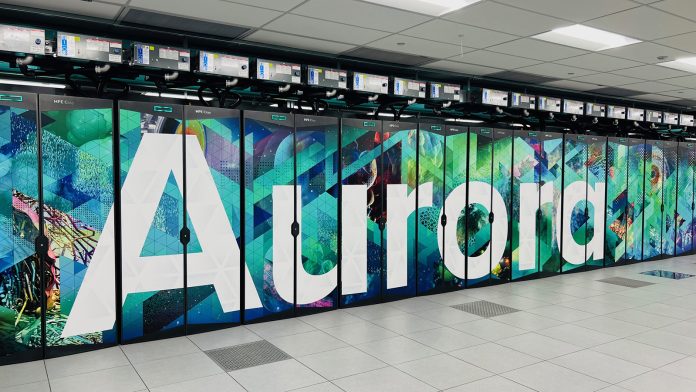
The United States Department of Energy’s Argonne National Laboratory has officially unveiled the Aurora supercomputer, marking a monumental leap in the evolution of high-performance, exascale computing.
Celebrated with a ribbon-cutting ceremony, the debut of Aurora highlights the culmination of years of collaboration between government scientists and industry leaders from Intel and Hewlett Packard Enterprise (HPE).
The Aurora supercomputer, already operational for scientific research, is not just a technical marvel – it’s a strategic asset positioned to accelerate breakthroughs in energy, medicine, aerospace, quantum computing, and beyond.
By integrating artificial intelligence (AI), large-scale simulations, and data analysis at unprecedented speeds, it sets a new benchmark for what supercomputing can achieve.
US Secretary of Energy Chris Wright likened the development of Aurora to the next Manhattan Project: “Aurora is a powerful example of what American science and innovation can deliver.
“As global competition accelerates, systems like Aurora give the United States a decisive edge in artificial intelligence, scientific discovery, and national security — fields where we can’t afford to fall behind.
“We’re at the start of a new Manhattan Project. If we don’t unleash American energy, innovation, and American science, we will lose Manhattan Project 2.
“The United States will win the AI race, but it will take energy dominance and strong public-private partnerships like the one behind Aurora to win this critical race.”
A titan among supercomputers
Aurora now stands among the world’s most powerful computing systems, achieving exascale performance – more than a quintillion (10¹⁸) calculations per second.
It joins the elite ranks alongside the DOE’s Frontier and El Capitan supercomputers, securing top positions on both the TOP500 list and the HPL-MxP benchmark, which measures AI performance.
Fuelled by 63,744 GPUs, Aurora is one of the largest GPU-driven systems ever constructed.
Developed in partnership with Intel and HPE, it leverages Intel’s unified architecture to blend AI and high-performance computing into a cohesive powerhouse for science.
Housed in the Argonne Leadership Computing Facility, this 10,000-square-foot system spans the area of two basketball courts and incorporates over 300 miles of network cabling with nearly 85,000 network endpoints – all kept cool by a sophisticated water-cooling system.
Scientific frontiers powered by Aurora
Aurora is not just a symbol of computational prowess – it’s already hard at work driving scientific discovery across multiple disciplines:
Revolutionising biomedical research
Researchers are harnessing Aurora’s power to model viral evolution, improve cancer treatment strategies, and map brain connectivity with unparalleled resolution.
By merging AI with physics-based simulation, Aurora is advancing drug discovery and global health preparedness, offering new tools to combat future pandemics and complex diseases.
Transforming aerospace engineering
In aviation, Aurora’s ability to simulate air flow at extreme detail is helping engineers better understand turbulence, shock waves, and aerodynamic lift.
Scientists are using the system to model airflow around next-generation aircraft and propulsion systems, reducing the need for physical prototypes and speeding up the design of quieter, more fuel-efficient aircraft.
Advancing fusion energy research
Aurora is playing a crucial role in pushing the boundaries of fusion energy, a potential game-changer in sustainable power.
Researchers simulate the intense conditions inside fusion reactors, such as the international ITER project, and use AI to predict the behaviour of energetic particles.
These insights are bringing scientists closer to achieving controlled, sustainable fusion power.
Supporting quantum computing development
Quantum researchers are turning to the Aurora supercomputer to validate quantum randomness – critical for secure communications – and simulate quantum algorithms aimed at solving complex molecular problems.
These efforts support hybrid approaches that blend quantum and classical computing to tackle future scientific challenges.
National collaboration driving global impact
The launch of the Aurora supercomputer reflects not only a technological milestone but also a model for public-private collaboration.
The combined efforts of the Department of Energy, Intel, HPE, and a network of global researchers showcase how aligning innovation, infrastructure, and expertise can create tools that transform entire scientific landscapes.
Available to researchers across the US and internationally through the DOE’s user facility network, Aurora is expected to catalyse innovation for years to come.
By enabling faster and more accurate analysis of complex systems, it promises to shape the next generation of technologies, from clean energy and personalised medicine to advanced materials and secure digital infrastructure.
Aurora sets the stage for tomorrow’s scientific frontiers
The Aurora supercomputer is more than just a record-breaking machine – it is a cornerstone for the future of science, built to empower discovery and solve the grand challenges of our time.
As researchers continue to explore its vast capabilities, Aurora stands ready to illuminate new paths in AI, simulation, and data-driven innovation.